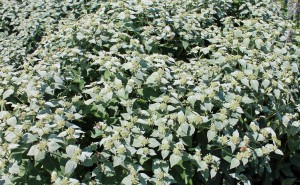Mountain mint
* Botanical name: Pycnanthemum muticum
* What it is: Sometimes called “clustered mountain mint” or “short-toothed mountain mint,” this native perennial has silvery-gray leaves and small clusters of pinkish flowers that form on cones at the top of the flower stalks in mid to late summer. It’s a bee magnet and tested out as the single best pollinator plant at Penn State’s trial garden in Lancaster County.
* Size: 2 to 3 tall, space 2 feet apart.
* Where to use: Prefers somewhat damp soil along woodland edges in nature, so any site similar to that is perfect. Mountain mint is also an excellent meadow plant, rain-garden plant and especially should be a centerpiece of any pollinator garden. Will do full sun, but a little bit of afternoon shade is better.
* Care: Needs little, if any, water or fertilizer once established. Also no spraying. The main care is to cut dead foliage close to the ground at the end of winter. Mountain mint is not an aggressive spreader like some mints. It can be dug and divided in early spring if it’s spreading beyond where you want.
* Great partner: Interplant with other bee-attracting native perennials, such as liatris, purple coneflowers, pink garden phlox, monarda and milkweed.









